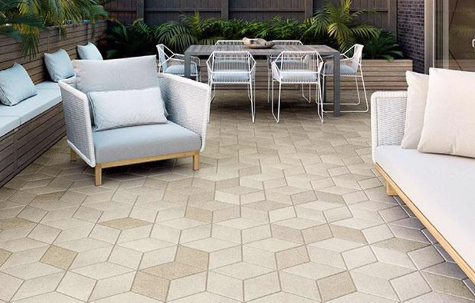Pavers or Concrete for your Outdoor Space?
When it comes to choosing the best paving material for your outdoor living space, you have a few options to consider. Two of the most popular choices are segmental concrete pavers and plain concrete. Both have their pros and cons, and understanding the differences between them can help you make an informed decision.
Techo-Bloc Granitex Diamond Style Paver
Segmental concrete pavers, also known as pavers, are individual blocks made of concrete that are used to create a paved surface. They come in a wide variety of shapes, sizes, and colors, making them highly customizable. Pavers are great for creating patterns and designs that can add visual interest to your outdoor space. They can also be easily replaced if one becomes damaged, making them a great option for high-traffic areas. Pavers also come in a variety of textures, colors, and styles that can blend seamlessly with any architectural style. They can be used in a variety of applications, including driveways, walkways, patios, and pool decks.
Stamped Concrete Pool Deck
Concrete, on the other hand, is a poured and finished surface that can be stamped, stained or stenciled to mimic the look of stone, tile or other materials. It is more durable than pavers, and it can be made to look like a variety of different materials, like cobblestone, brick, or tile. Concrete is also a great option for large areas, as it can be poured in one piece, which eliminates the need for seams and can make for a cleaner look. Additionally, concrete can be colored, stamped or stained to mimic the look of natural stone, brick, or tile.
Pavers are more flexible than concrete, they can be removed, rotated or replaced with ease. With pavers, you can also create a more natural look, with curves and irregular shapes, whereas concrete is more limited in this aspect. Pavers can also be more expensive than poured concrete, depending on the design of the space and materials used.
Concrete typically is more durable than pavers and can last longer without showing signs of wear. It also requires less maintenance, which is a big plus for homeowners who want to spend less time on upkeep. However, if a section of concrete becomes damaged, it can be difficult to repair or replace without leaving visible seams. Concrete is also more prone to cracking than pavers, especially in areas with heavy vehicular traffic.
Regardless of the type of paving material you choose, the proper compaction during construction is crucial for the longevity of the surface. A company that has the proper compaction and construction equipment with a background in masonry construction is critical for the integrity of either pavers or concrete construction.
In Conclusion
Both segmental concrete pavers and concrete have their own unique advantages and disadvantages when it comes to designing and constructing an outdoor living space. Pavers offer a wide range of customization options and are easy to replace, making them a great choice for high-traffic areas. They also come in a variety of textures, colors, and styles, that can blend seamlessly with any architectural style. Concrete, on the other hand, is a more durable option and requires less maintenance. It's also a great option for larger areas, as it can be poured in one piece, which eliminates the need for seams and can make for a cleaner look.
Ultimately, the choice between pavers and concrete comes down to personal preference, the design of the space, and the budget. Verardi Design Build in Pittsburgh, PA can help you make the best decision for your project, taking into account all the factors that are important to you, including durability, maintenance, and aesthetics, and bring your dream outdoor living space to life.


